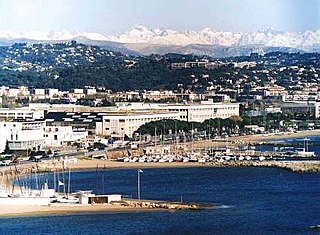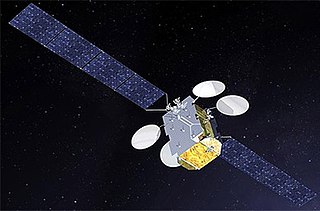The Long March rockets are a family of expendable launch system rockets operated by the China Aerospace Science and Technology Corporation. The rockets are named after the Chinese Red Army's 1934–35 Long March military retreat during the Chinese Civil War.

Spacebus is a satellite bus produced at the Cannes Mandelieu Space Center in France by Thales Alenia Space. Spacebuses are typically used for geostationary communications satellites, and seventy-four have been launched since development started in the 1980s. Spacebus was originally produced by Aérospatiale and later passed to Alcatel Alenia Space. In 2006, it was sold to Thales Group as Thales Alenia Space.
Apstar 6 is a communications satellite built by Alcatel Space, a subsidiary of Alcatel, and was boosted into orbit on April 12, 2005, by Long March 3B launcher from Xichang Satellite Launch Center in China. It provides APT Satellite, a satellite operator in the Asia Pacific region, with broadband media and television services. It is fitted with 38 C-band transponders and 12 Ku band transponders. China is covered with a dedicated high power Ku band beam for broadband multimedia transmission. It is the second model of the Spacebus 4000. The transponders have a reduced C-band receiving dish over a wide footprint, which extends across India, China and Australia.

Thales Alenia Space is a Franco-Italian aerospace manufacturer. A joint venture between the French technology corporation Thales Group (67%) and Italian defense conglomerate Leonardo (33%), the company is the largest satellite manufacturer in Europe. It is headquartered in Cannes, France.
ChinaSat is the brand name of communications satellites operated by China Satellite Communications.
Star One C1 is a Brazilian communications satellite. It was launched on 14 November 2007 by an Ariane 5ECA carrier rocket, as part of a dual-payload launch with Skynet 5B. It was built by Thales Alenia Space, based on the Spacebus-3000B3 satellite bus. It is operated by Star One, a subsidiary of Embratel.
The Regional African Satellite Communication Organization (RASCOM) will provide telecommunication services, direct TV broadcast services and Internet access in rural areas of Africa. Under an agreement with RASCOM, RascomStar-QAF will implement RASCOM's first 14 communications satellite project. This joint African project is expected to lower the continent's dependency on international satellite networks such as Intelsat.
Nilesat 201, is an Egyptian communications satellite, which was launched on 4 August 2010.
ChinaSat 9, also known as ZX-9, is a Chinese communications satellite.
Eutelsat 36B is a communications satellite in the W series operated by Eutelsat. It is co-located with Eutelsat 36A satellite at 36° East. It was launched on 24 November 2009, at 14:19:10 UTC, by a Proton launch vehicle.
Palapa-D was an Indonesian geostationary communications satellite which was operated by Indosat Ooredoo. It was built by Thales Alenia Space, based on the Spacebus-4000B3 satellite bus, and carries 35 C-band and 5 Ku-band transponders. It was positioned in geostationary orbit at a longitude of 113° East, where it will replace the Palapa-C2 satellite.
Eutelsat 21B, previously known as Eutelsat W6A, is a French communications satellite. Operated by Eutelsat, it provides direct to home broadcasting services from geostationary orbit at a longitude of 21.5 degrees east. It replaced the Eutelsat 21A spacecraft which was launched in 1999.

ChinaSat 12 communications satellite is wholly owned by China Satellite Communications, with part of its communications payload leased or rented by SupremeSAT, a Sri Lankan company to be marketed to potential users as SupremeSAT-I. Once operational, it will provide communications services for the China, Sri Lanka, East Asia, South Asia, Middle East, Africa, Australia and China sea area, the Indian Ocean region.
Yamal-402 is a Russian geostationary communications satellite. It was launched on 8 December 2012, 13:13:43 UTC from Site 200/39 at the Baikonur Cosmodrome in Kazakhstan. It was built by Thales Alenia Space, and is based on the Spacebus-4000C3 satellite bus. It is equipped with 46 Ku-band) transponders. It has a design life of 15 years, but reducing to 11 years expected after launch partial failure.

TürkmenÄlem 52°E / MonacoSAT is a communications satellite operated by Turkmenistan National Space Agency, built by Thales Alenia Space in the Cannes Mandelieu Space Center in France. Launched from Cape Canaveral on 27 April 2015 aboard a Falcon 9 v1.1 rocket, the satellite operates at 52°E in the geostationary orbit and has an anticipated service life of 15 years. The position is controlled by the Principality of Monaco and the satellite includes 12 transponders that are referred to and commercialised as MonacoSAT as well as the 26 transponders referred to as TürkmenÄlem.
Yamal-401 is a Russian geostationary communications satellite operated by Gazprom Space Systems. It was built by ISS Reshetnev and is based on the Ekspress-2000 satellite bus. It is equipped with 17 C-band and 36 Ku-band transponders. It has a design life of 15 years.

Ekspress-AM8 is a Russian communications satellite which was launched in 2015. Part of the Ekspress series of geostationary communications satellites, it is owned and operated by the RSCC Space Communications.
Yamal-601 is a Russian geostationary communications satellite ordered by Gazprom Space Systems from Thales Alenia Space (TAS) on the Spacebus-4000C4 satellite bus for its Yamal programme. The satellite has mass of 5,422 kg (11,953 lb) and 11 kW of payload power with over 15 years of design life. Its payload was also supplied by Thales Alenia Space and is composed of 38 C-band and 32 Ka-band transponders. It replaced Yamal-202 on 49° East as Yamal-202 was slated to reach its end of service around 2019.
AMC-9 is a commercial broadcast communications satellite owned by SES World Skies, part of SES S.A. Launched on 6 June 2003, from Baikonur Cosmodrome, Kazakhstan, on the 300th launch of a Proton family rocket, AMC-9 is a hybrid C-band / Ku-band satellite located at 83° West, covering Canada, United States, Mexico, and Caribbean. It is owned and operated by SES S.A., formerly SES Americom.

Eutelsat Konnect is a geostationary communications satellite operated by Eutelsat. The satellite was designed and manufactured by Thales Alenia Space on the Spacebus NEO 100 platform, and was launched on 16 January 2020 on an Ariane 5 ECA. The satellite provides broadband internet and communications coverage to Europe and Sub-Saharan Africa.





